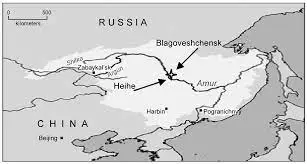【縛雞之論】英文拷到 G / D 找中文翻譯
The Heihe-Blagoveshchensk, a new 2,200-meter cross border and connecting
Russia and China across the Amur River, between Nizhneleninskoye in Russia and
Tongjiang city in China, were completed, with the first railway bridge at the
end of this year.
The BOT project is by Russia-China J.V. with Russia's contribution of USD 358m
and China's USD 81.7m. The J.V. will
operate the bridge for 20 years.
It looks like an extra-dosed bridge, with a span of 147m and a wide of 14.5m,
yet it is not.
It is a conventional continuous steel girder bridge with steel box girders and
stayed-cables supporting the concrete slab deck.
The design may not cause a problem because the span is only 145m, which needs
no extra help from the axial pre-stress by the stayed-cables.
Nevertheless, the bridge has a problem.
With the concrete lower structure isolated from the steel upper structure by
multilayers Typical lead-rubber bearing (LRB), the outward tilting steel towers
with cables have no tie-bars to balance the torque. The stress will concentrate on the inner part
of the transforming portion of the short pylons and the box girders. The lower structure and the upper structure
should link as one system.
2022-06-12
Blagoveshchensk–Heihe Bridge 黑龍江大橋:這不是低塔PC橋(大偏心PC橋),設計上有(致命?)缺失!
訂閱:
張貼留言 (Atom)


沒有留言:
張貼留言
請網友務必留下一致且可辨識的稱謂
顧及閱讀舒適性,段與段間請空一行